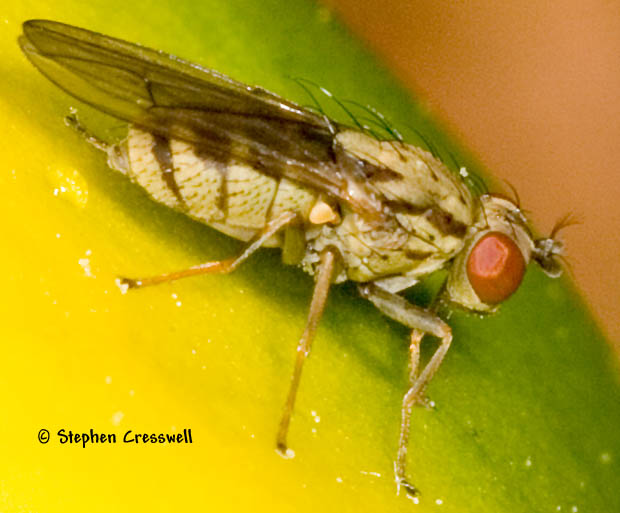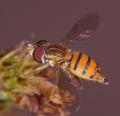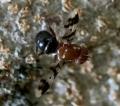Diptera.info :: Identification queries :: Diptera (adults)
Who is here? 1 guest(s)
|
Lauxaniid, oops, no, Ephydrid Fly
|
|
| Stephen |
Posted on 21-11-2006 11:50
|
|
Member Location: West Virginia USA Posts: 1322 Joined: 12.04.05 |
Tony and Paul have finally helped me figure out how to separate Lauxaniidae from other similar species. At least, from the orbital bristles, I believe this is Lauxaniidae. Is it possible to take the ID any further? Wetland in the mountains, West Virginia USA, 27 June 2005. Stephen attached the following image:  [77.76Kb] Edited by Stephen on 21-11-2006 12:57 --Stephen Stephen Cresswell www.americaninsects.net |
| jorgemotalmeida |
Posted on 21-11-2006 11:52
|
|
Member Location: Viseu - PORTUGAL Posts: 9296 Joined: 05.06.06 |
which is that way to distinguish? I count about 2 bristles in the orbit... I think.. |
| Kahis |
Posted on 21-11-2006 12:03
|
|
Member Location: Helsinki, Finland Posts: 1999 Joined: 02.09.04 |
Bad news  It is not a lauxanid but Notiphila (Ephydridae). The arista is a key clue: it has very long hairs on upper surface but none below. Not all Ephydrids have this type of arista, but most do and no other family has this type of arista* * Like all rules of nature this one has a few exceptions Kahis |
| Stephen |
Posted on 21-11-2006 12:28
|
|
Member Location: West Virginia USA Posts: 1322 Joined: 12.04.05 |
So Lauxaniids are still giving me trouble?or at least, flies that I think are Lauxaniids are giving me trouble!  Still, I am glad to get this one identified to the family and genus. Thank-you, Kahis! Edited by Stephen on 21-11-2006 12:28 --Stephen Stephen Cresswell www.americaninsects.net |
| Stephen |
Posted on 21-11-2006 12:41
|
|
Member Location: West Virginia USA Posts: 1322 Joined: 12.04.05 |
which is that way to distinguish? I count about 2 bristles in the orbit... I think.. After checking for arista that are plumose on only one side  , then you can apply the rule about orbital bristles. , then you can apply the rule about orbital bristles.I had asked how to tell Drosophilidae from Lauxaniidae, and the answer was the Lauxaniidae usually have two orbital bristles pointing toward the rear, while Drosophilidae have three orbital bristles, with the front one pointing toward the front and the rear two pointing toward the rear. Also, I read recently that the orbital bristles of the Lauxaniidae are evenly spaced out, but that at least two of the Drosophilid orbital bristles are very close together. --Stephen Stephen Cresswell www.americaninsects.net |
| Paul Beuk |
Posted on 21-11-2006 13:00
|
|
Super Administrator Location: Netherlands Posts: 19403 Joined: 11.05.04 |
I am not even certain that all Lauxaniidae have exactly two reclinate![header=[reclinate] body=[bent backward (usually used to indicate curvature of setae)<br /><img src='../infusions//terms/images/no_image.gif' style='vertical-align:middle;' />] delay=[0] fade=[on]](../infusions/terms/images/help.gif) pairs of orbital setae, but all Drosophilidae have two pairs of reclinate and one pair of proclinate pairs of orbital setae, but all Drosophilidae have two pairs of reclinate and one pair of proclinate![header=[proclinate] body=[bent forward (usually used to indicate curvature of setae)<br /><img src='../infusions//terms/images/no_image.gif' style='vertical-align:middle;' />] delay=[0] fade=[on]](../infusions/terms/images/help.gif) orbital setae. Usually the anterior pair of the reclinate orbital setae and the proclinate orbital setae are positioned close together. orbital setae. Usually the anterior pair of the reclinate orbital setae and the proclinate orbital setae are positioned close together.
Paul - - - - Paul Beuk on https://diptera.info |
| jorgemotalmeida |
Posted on 21-11-2006 13:12
|
|
Member Location: Viseu - PORTUGAL Posts: 9296 Joined: 05.06.06 |
opppss... I suppose that setae and bristles are the same thing. Two words meaning the same feature.  isn?t it? isn?t it?  |
| Stephen |
Posted on 21-11-2006 13:24
|
|
Member Location: West Virginia USA Posts: 1322 Joined: 12.04.05 |
Paul, thanks for clarifying the rule. Jorge, from what I understand seta refers to a hair or a bristle. In English, I think a bristle is just thicker than a hair. Someone correct me if I'm not saying this right. --Stephen Stephen Cresswell www.americaninsects.net |
| Tony Irwin |
Posted on 23-11-2006 17:10
|
|
Member Location: Norwich, England Posts: 7280 Joined: 19.11.04 |
This looks like Notiphila taenia, though the species is very similar to N. bella. Certainly one or the other.
Tony ---------- Tony Irwin |
|
|
|
| Robert Nash |
Posted on 23-11-2006 18:02
|
|
Member Location: Ulster Museum, Belfast, Ireland Posts: 288 Joined: 11.11.05 |
Splitting hairs- seta the Latin word seta which is feminine and means bristle chaeto- is formed after the Greek word chaite meaning long hair or mane chaetotaxy formed after chaeta is used to refer to taxa(onomy) based on bristles, which contradicts. Add to this the confusions caused by translation Borste is German for bristle (sometimes, figures occasionally show slender spines) but bristle En fran?ais is brin a word seldom used in keys. Then cross translation say German-French-English   makes matters much worse. makes matters much worse.In short no certain definition here and a lot depends on magnification and lighting when bristle is qualified -small,minute, tiny etc I am putting together some thoughts on this and related subjects under http://en.wikiped...tomous_key Skip the plant key bit (I need to put together a separate insect key page) and go down Keys versus descriptions and then onwards. Any comment or problem let me know.Especially comment. Robert Edited by Robert Nash on 23-11-2006 18:11 |
| jorgemotalmeida |
Posted on 23-11-2006 19:37
|
|
Member Location: Viseu - PORTUGAL Posts: 9296 Joined: 05.06.06 |
once again, Robert Nash in great style! well done! |
| Stephen |
Posted on 24-11-2006 23:27
|
|
Member Location: West Virginia USA Posts: 1322 Joined: 12.04.05 |
Robert, I enjoyed the Wikipedia entry very much, it makes some really good points. Hairs, bristles, seta, and just recently I ran across another one, setula. Lots of interesting words like this. I have found reference to tubercles and tubercules, are they the same thing? And how are they different from "warts" and protruberances? It can be really challenging in English negotiating all these terms and my admiration is even greater for the Czechs and Dutch and Hungarians and Russians, and yes, Portugese, who use this site! My hat is off to you! --Stephen Stephen Cresswell www.americaninsects.net |
| Jump to Forum: |













